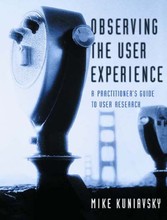Search and Find
Service
Front Cover
1
Observing the User Experience
6
Copyright Page
7
Contents
10
Preface
14
PART I: Why Research is Good and How It Fits Into Product Development
18
CHAPTER 1. Typhoon: A Fable
20
The Short History of Typhoon
21
CHAPTER 2. Do A Usability Test Now!
26
A Micro-Usability Test
26
What Did You Learn?
31
What to Do Next
32
CHAPTER 3. Balancing Needs Through Iterative Development
34
Success for End Users Is
35
Success for Advertisers Is
37
Success for the Company Is
40
A System of Balance: Iterative Development
45
Iterative Development and User Research
52
Example: A Scheduling Service
53
CHAPTER 4. The User Experience
60
Information Architecture
61
Interaction Design
65
Identity Design
67
The User Experience Research
69
PART II: User Experience Research Techniques
72
CHAPTER 5. The Research Plan
74
Goals
74
Schedules
82
Budget
92
Research Plan for Company X
94
Maintenance
99
CHAPTER 6. Universal Tools: Recruiting and Interviewing
100
Recruiting
100
Interviewing
134
CHAPTER 7. User Profiles
146
When to Do It
148
How to Do It
149
Using Profiles
167
Example
172
CHAPTER 8. Contextual Inquiry,Task Analysis, Card Sorting
176
Contextual Inquiry
177
Task Analysis
199
Card Sorting
209
CHAPTER 9. Focus Groups
218
When Focus Groups Are Appropriate
219
How to Conduct Focus Groups
224
Focal Group Analysis
257
Example
265
CHAPTER 10. Usability Tests
276
When to Test
277
How to Do It
281
How to Analyze It
310
Example
314
CHAPTER 11. Surveys
320
When to Conduct Surveys
321
How to Field a Survey
322
How to Analyze Survey Responses
357
Follow-Up and Ongoing Research
374
CHAPTER 12. Ongoing Relationship
384
Background
385
Diaries
386
Advisory Boards
402
Beta Testing
408
Telescoping
410
Taking the Longer View
410
CHAPTER 13. Log Files and Customer Support
412
The Customer Support Process
413
Collecting Comments
414
Reading Comments
415
Organize and Analyze Them
416
Log Files
419
What’s in a Log File, and What’s Not
420
Logs and Cookies
423
Some Useful Metrics
426
Extracting Knowledge from Data
431
CHAPTER 14. Competitive Research
436
When Competitive Research is Effective
437
Competitive Research Methods
438
Analyzing Competitive Research
448
Acting on Competitive Research
450
Example: A Quick Evaluation of ZDNet
451
CHAPTER 15. Others’ Hard Work: Published Information and Consultants
456
Published Information
457
Hiring Specialists
464
CHAPTER 16. Emerging Techniques
476
Variations on Techniques
476
Combining
486
PART III: Communicating Results
494
CHAPTER 17. Reports and Presentations
496
Preparation
497
The Report
500
The Presentation
511
CHAPTER 18. Creating a User-Centered Corporate Culture
522
Integration
523
Justification
533
What If It’s Too Difficult?
542
The Only Direction
544
Appendix A: The Budget Research Lab
546
Appendix B: Common Survey Questions
549
Appendix C: Observer Instructions
555
Bibliography
559
Index
562
About the Author
577
All prices incl. VAT














